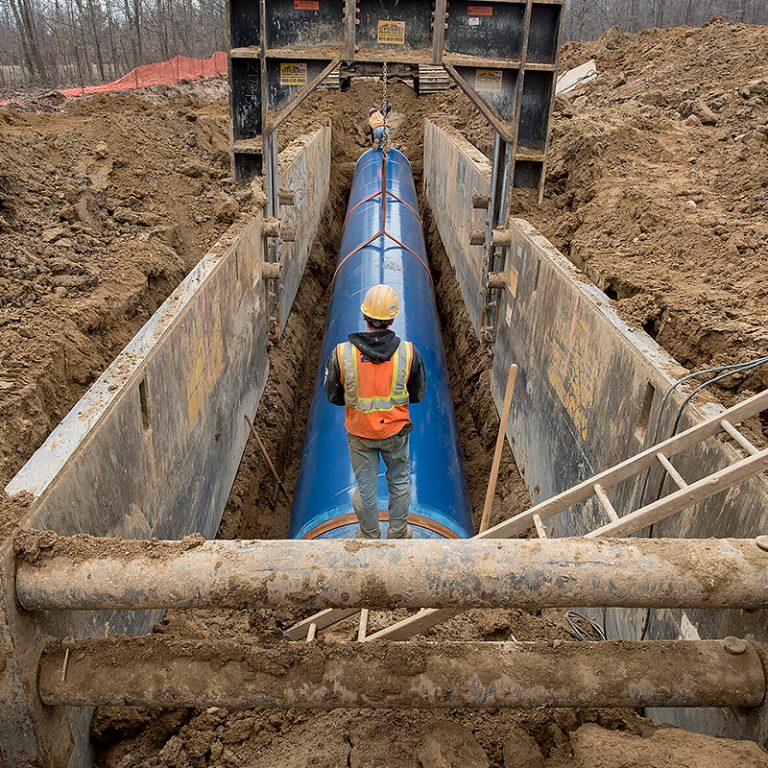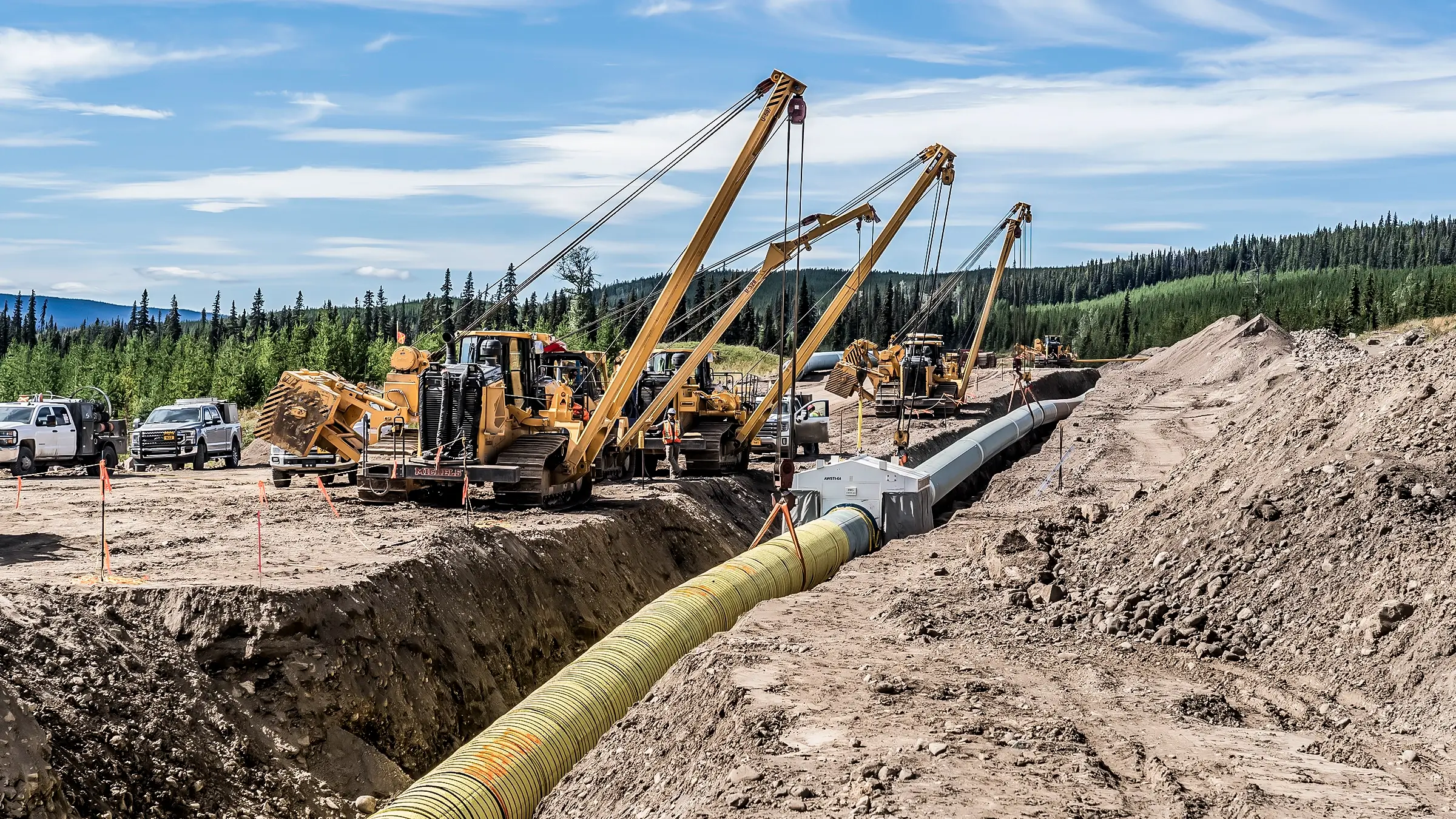Complete Walkthrough to Successful Creek Pipe pipeline construction
Wiki Article
The Relevance of Pipeline Construction: Checking Out the Providers Used in the Industry
Pipeline construction is a crucial part of contemporary infrastructure. It promotes the transportation of essential sources like oil, gas, and water. The industry incorporates various solutions, consisting of preparation, website prep work, and setup. Each stage requires precision and adherence to safety and security requirements. As areas depend on these systems for their source of incomes, understanding the ins and outs of pipe construction reveals its relevance and possible challenges. What aspects affect the success of these projects?Introduction of Pipeline Construction Solutions
Pipeline construction solutions encompass a series of customized tasks developed to assist in the installation of pipes for moving numerous substances, including oil, gas, and water. These services commonly consist of site preparation, excavation, setup of pipe sectors, and backfilling. Skilled labor and advanced devices are essential for assuring each stage is implemented with accuracy and safety.Safety protocols are paramount, as these projects typically include dealing with harmful products and in tough settings. Quality assurance actions identify that the pipes fulfill sector criteria and laws. In addition, the solutions might include trenchless innovation, which lessens surface area disruption.Environmental considerations play a substantial function in pipe construction, needing assessments and mitigations to protect surrounding communities. In general, pipeline construction solutions are essential for developing the framework needed for energy and water distribution, sustaining both financial development and societal needs.Planning and Layout in Pipeline Projects
Reliable planning and design are critical components of effective pipeline projects, ensuring that all facets are carefully addressed before construction starts. This phase involves detailed expediency research studies that evaluate the technological, financial, and environmental factors affecting the job. Engineers and developers work together to create detailed strategies that describe the pipeline path, materials, and construction methods, straightening with regulative requirements and market standards.Advanced software and modeling strategies are frequently used to mimic numerous situations, maximizing the style for performance and security. Ecological impact analyses are conducted to alleviate potential damage to ecosystems and neighborhoods, mirroring a commitment to sustainable techniques. Additionally, stakeholder involvement is essential, promoting interaction and resolving problems from affected celebrations. Inevitably, effective planning and layout established the foundation for a pipeline job, decreasing risks and making sure a structured construction procedure, ultimately contributing to the general success of the procedure.Website Prep Work and Excavation
Comprehensive site prep work and excavation are crucial actions in the pipeline construction process. This phase includes an in-depth analysis of the land where the pipe will certainly be installed. Project teams conduct surveys to determine soil types, topography, and existing utility lines to ensure a risk-free and effective excavation. Correct website prep work lessens ecological influence and promotes smoother construction operations.Excavation adheres to, where hefty equipment is used to get rid of dirt and rock, producing a trench that satisfies the specified depth and width for the pipeline. This procedure has to comply with safety and security laws and ecological standards to stop damage to surrounding ecosystems.Additionally, erosion control measures are implemented to maintain the website during and after excavation. Effective site prep work and excavation add considerably to the general success of pipeline tasks, laying a strong foundation for the subsequent stages of construction.Pipeline Installation Strategies
Pipeline installation methods are vital for the successful implementation of framework jobs. Two prominent approaches include trenchless technology, which decreases surface area interruption, and the open-cut excavation process, recognized for its uncomplicated technique. Each technique offers distinctive advantages and considerations relying on job needs and environmental factors.Trenchless Modern Technology Techniques
While traditional techniques of pipeline installment typically involve substantial excavation, trenchless technology approaches provide an extra effective and eco-friendly choice. These ingenious strategies, such as horizontal directional exploration and pipe bursting, lessen surface interruption by permitting the setup of pipes without comprehensive excavating. This not just lowers the ecological impact however also considerably cuts down on labor and repair costs. Trenchless techniques promote the installation of pipelines in city locations where conventional excavation would certainly be not practical or damaging to existing facilities. In addition, these techniques can fit different dirt kinds and conditions, making them flexible options for pipe construction. Ultimately, trenchless technology represents a significant innovation in the Creek Pipe Midland pipeline industry, promoting sustainability and operational effectiveness.
Open-Cut Excavation Refine
Open-cut excavation continues to be a basic strategy in pipe setup, defined by the direct excavation of a trench to lay pipes. This method involves removing dirt and various other products to produce a trench of adequate depth and width, enabling the positioning of pipelines at the needed grade. Open-cut excavation is frequently chosen for its cost-effectiveness and simplicity, specifically in locations with steady soil conditions. It can interrupt surface tasks and calls for cautious planning to take care of web traffic and environmental influences. Precaution should be implemented to shield workers and nearby framework during the excavation procedure. Generally, while open-cut excavation may not appropriate for all surfaces, it remains an extensively utilized approach in pipe construction.Testing and Quality Control
Testing and quality control are essential elements in pipe construction, ensuring that installations fulfill recognized safety and security requirements and efficiency requirements. Numerous inspection strategies and methods are utilized to assess material top quality and adherence to regulatory conformity. This systematic method aids identify prospective issues before they intensify, safeguarding the stability of the pipe system.
Examination Techniques and Methods
Examination methods and techniques are essential parts in ensuring the stability and security of pipeline construction. Various approaches, including aesthetic assessments, ultrasonic testing, and radiographic examinations, are utilized to discover problems and validate top quality. Aesthetic examinations enable for the identification of surface anomalies, while ultrasonic screening utilizes sound waves to evaluate wall surface density and situate problems inside. Radiographic evaluations entail X-rays or gamma rays to produce pictures of the pipe's framework, revealing covert concerns. In addition, pressure testing is carried out to examine the pipe's honesty under operational conditions. These methods collectively add to a thorough understanding of the pipeline's condition, enabling timely maintenance decisions and making sure conformity with sector criteria. Reliable examination is crucial for avoiding failures and promoting long-lasting operational safety.Safety Criteria Compliance
Guaranteeing compliance with safety standards is paramount in pipeline construction, as it straight influences the task's total high quality and dependability. Adhering to well established policies and guidelines guarantees that construction practices minimize threats connected with pipeline setup and operation. Creek Pipe pipeline construction. Rigorous screening procedures, including non-destructive screening and stress assessments, are crucial in confirming that pipelines can withstand the functional tensions they will run into. Quality control steps are also crucial, as they develop a framework for regular tracking and evaluation throughout the construction procedure. By prioritizing safety and security requirements conformity, business not only secure workers and the setting but additionally improve the honesty of the pipeline, inevitably resulting in lasting operational success and public count on the facilitiesProduct High Quality Analysis
Material top quality assessment plays a substantial role in the general integrity of pipeline construction. This procedure involves extensive screening and quality control steps to assure that materials satisfy sector standards and specs. Numerous tests, including tensile toughness, corrosion resistance, and weld stability evaluations, are performed to identify any type of possible weak points. An extensive analysis not only guarantees the performance of the pipe yet also enhances security and longevity over its lifespan. Furthermore, carrying out top quality control methods helps mitigate risks connected with product failings, which can cause pricey fixings and environmental hazards. By prioritizing material high quality assessment, business can ensure conformity with regulative demands while promoting confidence among stakeholders in the dependability of their pipeline systems.Maintenance and Repair Work Solutions
Repair and maintenance services play a vital function in the longevity and efficiency of pipeline systems. These solutions incorporate normal assessments, fixing, and restorative actions to address wear and tear, leakages, and various other problems that may arise over time. Skilled professionals make use of sophisticated innovations such as ultrasonic testing and clever pigging to keep an eye on pipeline integrity, making certain that any kind of prospective problems are recognized early.Additionally, maintenance programs frequently consist of set up safety nets made to improve system reliability and lower the probability of unexpected failings. Repair services might include the substitute of damaged sections, securing leaks, or using trenchless innovation for minimal interruption.Environmental Compliance and Safety And Security Steps
Pipeline systems not just need recurring repair and maintenance to work efficiently however also need to abide by rigid environmental compliance and safety and security steps. These regulations are necessary for minimizing environmental impact and guaranteeing public safety and security. Companies in the pipe construction sector execute detailed environmental evaluations prior to project initiation, determining possible risks to wildlife and ecosystems.Furthermore, adherence to security methods protects workers and bordering areas. This includes routine training on emergency situation feedback and spill prevention techniques.To maintain compliance, sectors use keeping track of innovations to identify leaks and other anomalies in real-time. Environmental administration strategies are often developed to describe steps for attending to unpredicted concerns during construction.Ultimately, strict adherence to environmental compliance and safety steps not only satisfies legal responsibilities however likewise cultivates lasting techniques within the sector, advertising an equilibrium in between facilities advancement and environmental stewardship.Often Asked Concerns
What Profession Opportunities Are Offered in Pipeline Construction?
Profession chances in pipeline construction encompass roles such as task supervisors, designers, welders, and security inspectors. These positions require varied abilities, offering pathways for growth in an important sector of framework growth and power distribution.

Exactly How Do Pipeline Projects Effect Resident Communities?
Pipeline projects substantially affect local areas by affecting economic development, offering job possibilities, and improving infrastructure. They might also increase concerns concerning environmental impacts, land use, and possible disruptions to neighborhood cohesion and natural ecosystems.
What Innovation Is Used in Modern Pipeline Construction?
Modern pipeline construction makes use of sophisticated modern technologies such as GIS for mapping, drones for aerial studies, and automated welding systems to boost effectiveness, safety and security, and precision, inevitably assisting in the effective transportation of sources across numerous surfaces. Creek Pipe near me.How Are Pipeline Construction Expenses Approximated?
Pipeline construction prices are estimated with detailed evaluations of products, labor, tools, and regulatory requirements. Aspects like surface, task size, and environmental considerations likewise substantially affect the overall budget and monetary planning for construction.What Are the Largest Obstacles in Pipeline Construction Projects?
The biggest challenges in pipeline construction projects include regulatory compliance, environmental issues, logistical problems, protecting funding, and handling labor lacks. Each element can considerably affect timelines and budget plans, complicating the general execution of the project.Report this wiki page